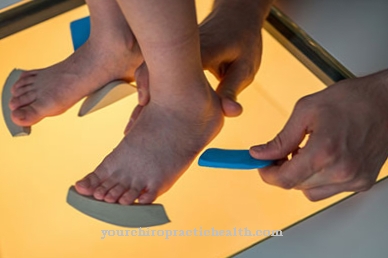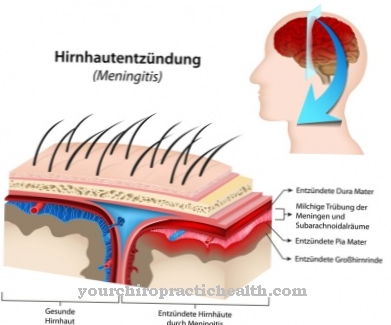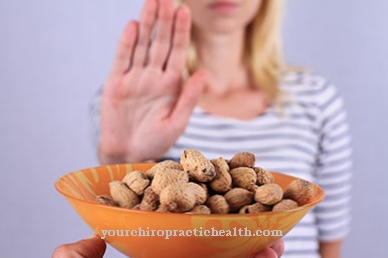As Mastopathy is the benign change in glandular tissue in the female breast. Symptoms include swelling and tightness in the chest, which are often associated with menstruation, or palpable lumps and cysts in the chest.
What is mastopathy?

The Mastopathy - also Breast dysplasia called - describes changes in the glandular body of the female breast that are benign. More than half of all women between the ages of 35 and 50 suffer from mastopathy, which makes this disease one of the most common diseases of the mammary gland in women.
Women under the age of 25 and women going through menopause are only affected in a few exceptional cases. Depending on the type of change in the glandular tissue, different forms of mastopathy are distinguished:
Fibrous mastopathy: vitreous connective tissue replaces the layer of tissue that lines the glandular ducts inwards
Fibrocystic Mastopathy: the connective tissue increases and gland ducts expand
Fibroadenomatous Mastopathy: Glandular tissue cells multiply like tumors and can be filled with pus, blood or secretion
In addition, mastopathy is divided into three groups with varying degrees of severity of the tissue changes, which doctors use to assess the risk of breast cancer.
causes
The causes for Mastopathy are not yet fully clarified. Those affected are likely to have an imbalance between the hormones estrogen and progesterone, which are involved in the cycle. Women with proven mastopathy have too much estrogen; this excess is the cause of the changes in the mammary gland tissue.
As a rule, sexually mature women develop mastopathy. When women go through menopause, the symptoms usually go back automatically with the accompanying hormonal changes. Several possible causes can be named for the excess of estrogen, such as other hormonal diseases of the thyroid gland, which can also be the cause of the mastopathy.
Typical symptoms & signs
- Chest pain
- Chest tightness
- Breast lump
- Pathological secretion of the mammary gland
Diagnosis & course
If there is a suspicion of a present Mastopathy, a medical history must first be taken. The family doctor will refer the affected women to the gynecologist, who will feel the breasts. If there is mastopathy, the doctor feels irregularities in the glandular body when touching it, and possible lumps in the breast can be easily felt.
This finding is usually more pronounced before the onset of the menstrual period than after it. In order to substantiate the diagnosis, an ultrasound examination of the breast is usually arranged. Mammography can provide further information on whether mastopathy is present and can also detect small tissue calcifications.
If calcifications can be found during the mammography, these are removed and the tissue is examined microscopically. If there are cysts in the breast, they are punctured and the contents examined for changes in the cells. In cases where fluid leaks from the nipple, the secretion is examined more closely to clarify the causes.
Complications
Mastopathy can cause pain and severe swelling of the breast tissue. While breastfeeding, mastopathy can cause the milk ducts to become blocked. This can lead to a blockage of the milk and a febrile inflammation as a result. Occasionally, mastopathy can also lead to uncontrolled secretion from the nipple.
This can represent a psychological burden for the women concerned and sometimes also lead to social stigmatization. Mastopathy itself can also be emotionally stressful. Even a harmless lump in the breast can cause anxiety and depression.
This can lead to pain and a permanent feeling of pressure, which can increase the psychological stress. Breast cancer rarely develops from mastopathy. Cancer is associated with other physical and psychological complications that require long-term treatment.
Drug therapy for mastopathy can cause problems if the prescribed painkillers lead to side effects and allergic reactions. The active ingredients that are mostly used (paracetamol, ketoprofen, ibuprofen, diclofenac, among others) can cause headaches, dizziness and visual disturbances. Severe allergic reactions such as rashes and breathing difficulties occur rarely.
When should you go to the doctor?
If changes in the glandular tissue in the breast can be felt, they should be compared with the female cycle. If the symptoms occur immediately before the onset of menstrual bleeding, the chest should be palpated again after the menstrual period has subsided. If the swelling has completely subsided within a few days, a doctor is not required. In these cases it is a question of a natural development of the female organism that does not require any treatment. If you are still uncertain or fearful, it is advisable to see a doctor. Other symptoms shortly before your period may include chest pain or a feeling of tightness. If symptoms persist after menstruation, a medical check-up should be initiated immediately.
In the case of persistent or increasing swelling, palpable lumps or other irregularities, clarification of the complaints is necessary. Although mastopathy is a benign change in the tissue and therefore not a potentially life-threatening disease of the breast, the abnormalities of the glandular tissue occur exclusively in connection with the menstrual cycle. Persistent irregularities are signs of another health impairment. Medical tests are required to make a diagnosis and should therefore be used. It is advisable to visit a doctor as soon as possible so that the cause can be clarified at an early stage.
Treatment & Therapy
Treatment of the Mastopathy is primarily aimed at alleviating the symptoms associated with mastopathy. Because the cause is often an excess of estrogen - i.e. an imbalance in the hormonal balance - this excess is compensated by the administration of progestin. The intake takes place depending on the cycle starting on the 16th and ending on the 25th day of the cycle.
Prolactin inhibitors are used to counteract any tension that may occur and the cystic changes in the breast; if the symptoms are more severe, the doctor can also prescribe a drug with the active ingredient danazol, which causes less estrogen to be released.
In very rare exceptional cases, if the patient has a mastopathy, the breast is removed if the risk of breast cancer is particularly high, if the woman has a third-degree mastopathy and is not older than 40 years.
Outlook & forecast
The prognosis of mastopathy is linked to the causal disorder. If the symptoms occur during pregnancy or after childbirth while breastfeeding, a complete cure can be expected as soon as the breastfeeding period is over. If the health irregularities can be traced back to the monthly menstrual bleeding, the symptoms will be completely free at the latest when the menopause begins and the menstrual period naturally ends automatically. Even without treatment or therapy, there is a long-term recovery.
However, there are risk factors that must be taken into account when making a prognosis. If the pain in the chest or the feelings of tension are very pronounced, emotional states of stress can arise, depending on the personality of the patient concerned. If the outcome is unfavorable, these can lead to the development of a mental illness. In addition, cysts or breast lumps can trigger the mastopathy.
Surgery is often necessary in order to be free of symptoms. Any intervention in the organism is associated with an increased risk of complications. Nevertheless, in most cases it is a routine intervention that runs smoothly. If the course of the disease is very unfavorable, the risk of developing cancer is increased. If left untreated, this can lead to premature death.
prevention
There are preventive measures at the Mastopathy Unfortunately not. It is not known that there is anything women can do to prevent the changes in the breast tissue. Nevertheless, it is recommended that all women feel their breasts themselves regularly once a month in order to identify changes quickly and to seek medical help immediately if abnormalities appear and the first pain is present.
Aftercare
Mastopathy itself can be treated well in many cases if it is recognized early. Follow-up care focuses on the early detection of new symptoms. If these occur unexpectedly, this should be clarified with the treating doctor to make sure that there is no serious reason behind it. In the case of severe pain, those affected should consult a doctor and possibly have pain pills prescribed. If you have unusual symptoms and complaints that persist longer than usual, you should see a gynecologist with a mastopathy.
In general, those affected should concentrate on a healthy lifestyle with sufficient exercise in the fresh air and a balanced diet that includes plenty of fresh food. Yoga and other relaxation exercises can help to increase your well-being over the long term.
You can do that yourself
In order to rule out a serious illness, mastopathy should definitely be examined by the gynecologist.The individual symptoms can be alleviated through self-help measures.
Cooling compresses, which are best placed on the breasts for ten to fifteen minutes at a time, help with pain. The feeling of tension in the breasts is relieved with the help of herbal teas, for example hibiscus or sage tea and other varieties that have a dehydrating or analgesic effect. Some women find a sauna visit beneficial - but the draining effect does not last long. A well-fitting bra supports the breasts and relieves both pain and uncomfortable tension. Dietary measures will help on the bad days. Coffee, black tea, sweet drinks and chocolate are best avoided because their ingredients can exacerbate the symptoms. Healthy foods such as fruits, vegetables and whole grains are better. Monk's pepper preparations are suitable from herbal medicine. Homeopathy also recommends the preparations Aristolochia, Conium and Sabal serrulata.


.jpg)

.jpg)
.jpg)





















